Fruit Tree Nurseries Recommend These 15 Award-Winning Apple Tree Varieties

Reviewed By COLIN SKELLY

Colin is a Horticulturist and Horticultural Consultant with experience in a range of practical and managerial roles across heritage, commercial and public horticulture. He holds the Royal Horticultural Society’s Master of Horticulture award and has a particular interest in horticultural ecology and naturalistic planting for habitat and climate resilience.
Contributions From TOM ADAMS

Tom's nursery specialises in a range of fruits, including apples. The nursery has been certified Organic by the Soil Association and has been featured in The Guardian and The Daily Telegraph for its work.

Julie and the team strive to do more for the community than just grow trees. Described as a ‘social enterprise tree nursery’, Sheffield Fruit Trees is a not-for-profit organisation that is working towards planting more edible trees across the whole of Sheffield to connect more people to their food.
IN THIS GUIDE
- Expert Chosen Varieties
- Our Chosen Varieties
- 1) M. domestica ‘Scrumptious’
- 2) M. domestica ‘Discovery’
- 3) M. domestica ‘Howgate Wonder’
- 4) M. domestica ‘Bramley’s Seedling’
- 5) M. domestica ‘Ellison’s Orange’
- 6) M. domestica ‘Peasgood’s Nonsuch’
- 7) M. domestica ‘Blenheim Orange’
- 8) M. domestica ‘Pixie’
- 9) M. domestica ‘Ribston Pippin’
- 10) M. domestica ‘Rosemary Russet’
- 11) M. domestica ‘Elstar’
- 12) M. domestica ‘Greensleeves’
- 13) M. domestica ‘Worcester Pearmain’
- 14) M. domestica ‘Red Windsor’
- 15) M. domestica ‘Cox Orange’
- References
Apples are surely among the most popular fruits in every region around the world and the UK is certainly no exception.
All apple cultivars descend from Malus domestica, which belongs to the Rose Family, and there are thousands of cultivars to choose from.1The Apple and the Rose. (2021, May 8). Apples and People. Retrieved March 9, 2023, from https://applesandpeople.org.uk/stories/the-apple-and-the-rose/
Expert Chosen Varieties
When writing this guide, we consulted two of the top apple tree nurseries in the UK, including Tom Adams, the owner of Tom Adams Fruit Tree Nursery.
“Before selecting an apple tree to grow, do some research into which varieties you like and select a rootstock that is right for your space.
“Popular varieties from my nursery include ‘Discovery’ because it is always a great start to the apple season and is very resistant to disease.
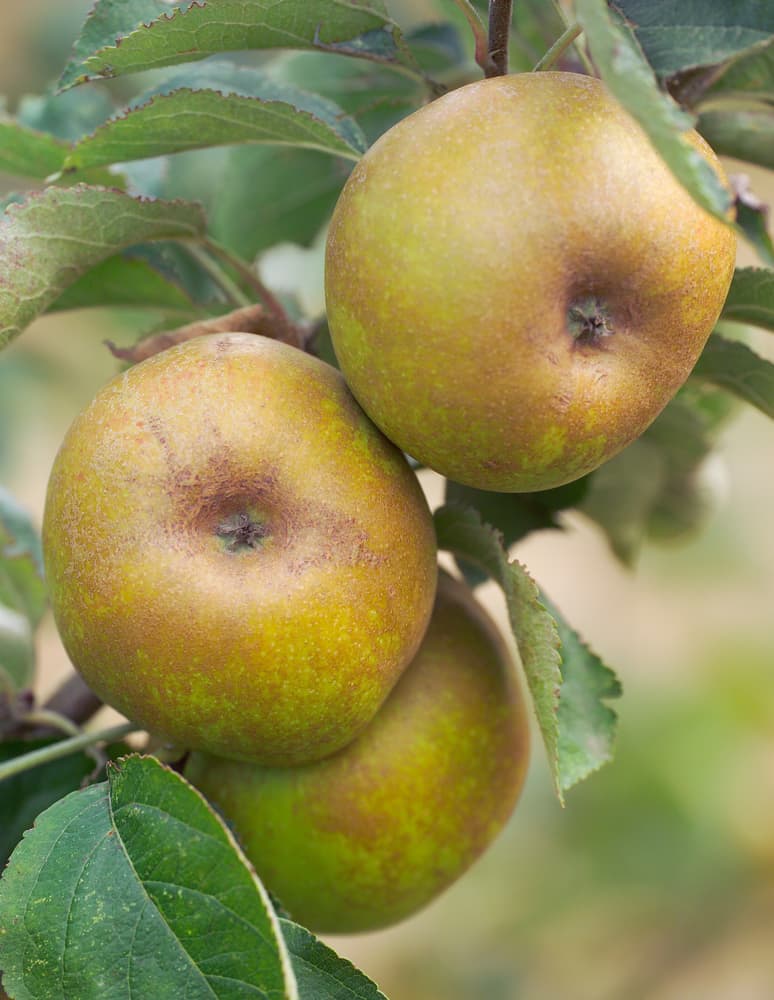
“‘Ashmead’s Kernel’ is one of the tastiest apples ever, is a great keeper and is also very resistant to disease.
“Finally, I love ‘Puckrupp Pippin’. It is a very rare russet from the Welsh and English borderlands with exceptional flavour.”
Julie Bellemann from Sheffield Fruit Trees explains the importance of choosing and growing specific varieties.
“These days, we’re all aware that the pressures of climate change, biodiversity loss and air pollution mean we need to be planting more trees and getting our food from closer to home.
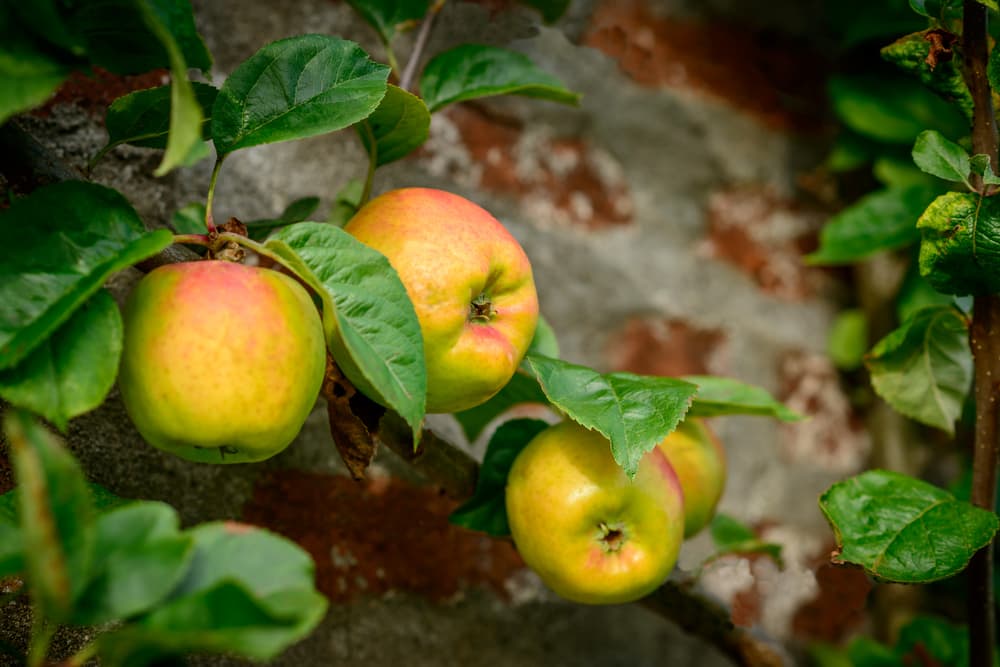
“Fruit trees are a great response to these challenges and have the added bonus of making our communities more beautiful and social places to be in, leaving a natural legacy for future generations.
“A lot of our varieties are local to Sheffield and part of our project is to make sure these do not get lost.
“To save specific varieties for the future, such as lone trees growing on riverbanks like the ‘Sheaf Pippin’, a tree that is most likely going to be cut down very soon due to redevelopment, is very important.”
Our Chosen Varieties
With our experts’ opinions taken into consideration, here is my list of brilliant varieties for you to grow in your garden.
They are all perfect for growing here in the UK as they are all recipients of the RHS Award of Garden Merit.
As this guide is meant for homeowners and hobbyist gardeners, we have selected a few varieties that are meant for small gardens and those that are self-fertile.
“Self-fertile cultivars have the advantage that they can be grown singly rather than needing 1 or more companions to be pollinated,” explains Master Horticulturist Colin Skelly.
“However, once you have one, if you are anything like me, the temptation will be to squeeze one more in!
“I’ve trained my apples as espaliers and then added step-overs to optimise the space and maximise the enjoyment in my garden.”
Although this guide generally lists dessert or eating apples, I also share a few cooking apples, so keep your eyes peeled for those.
Apple trees are fully hardy at H6 and all can be grown in most fertile soils with a neutral pH.
1) M. domestica ‘Scrumptious’

- COMMON NAME(S): apple ‘scrumptious’
- TYPE: EARLY DESSERT APPLE
- FLOWERS: pink
- FRUIT: red
- SUNLIGHT: full sun
- SIZE: 4-8m in height, 4-8m spread
’Scrumptious’ in more ways than one, this tree is a marvellous sight in spring when it bears delicate, pastel pink flowers.
These develop into glowing red fruit, ready for picking from late August to early September.
The fragrant apples have a rich and honeyed flavour, yet it is a complex taste with hints of various other flavours.
It is self-fertile so will not need to be planted near other apple trees.
2) M. domestica ‘Discovery’

- COMMON NAME(S): apple ‘discovery’
- TYPE: EATING / CULINARY
- FLOWERS: white
- FRUIT: red and green
- SUNLIGHT: full sun
- SIZE: 2.5-8m in height, 2.5-8m spread
A popular and easy-to-source cultivar, ‘Discovery’ has a height ranging from 2.5-8m and is easy to grow, making it a top choice for small gardens.
It bears white flowers followed by blush red and green fruit.
The apples are crisp, juicy and tart and are good choices for juicing and making cider – as well as eating!
Another self-pollinator, these fruits are ready to harvest from mid-August through September.
3) M. domestica ‘Howgate Wonder’
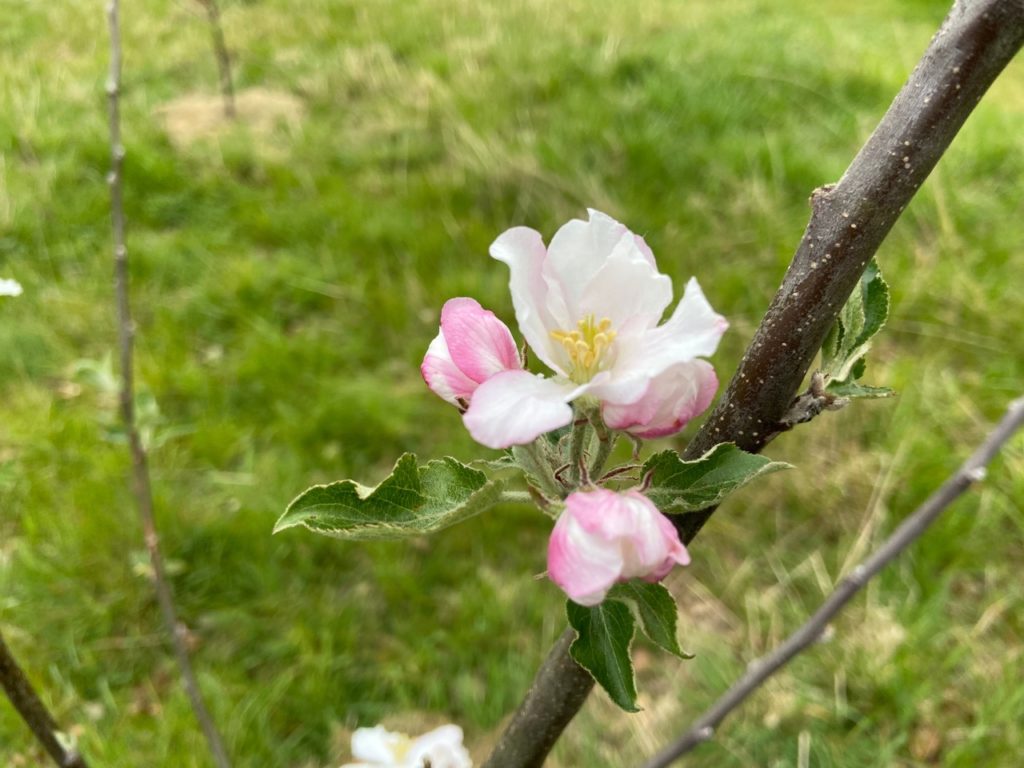
- COMMON NAME(S): apple ‘howgate wonder’
- TYPE: CULINARY / EATING
- FLOWERS: pink and white
- FRUIT: red, green and yellow
- SUNLIGHT: full sun
- SIZE: 4-8m in height, 4-8m spread
Among the largest apple tree varieties, ‘Howgate Wonder’ is as vigorous as its tall stature would suggest and it is a prolific producer of apples.
Its fruits are designated for culinary uses, but they are also delicious to eat when plucked straight from the tree.
They are gently shaded in yellows, pale greens and light reds and the plant also bears pink-flushed blossoms in spring.
October is the prime harvesting month for these self-pollinators.
4) M. domestica ‘Bramley’s Seedling’
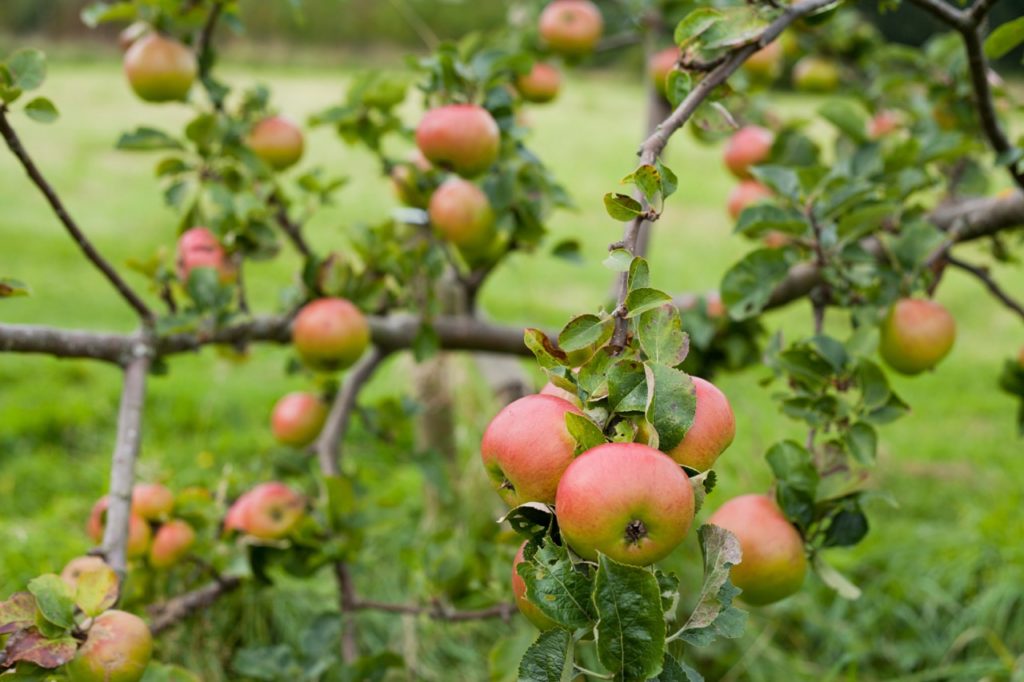
- COMMON NAME(S): apple ‘bramley’s seedling’
- TYPE: CULINARY
- FLOWERS: pink
- FRUIT: red and green
- SUNLIGHT: full sun
- SIZE: 2.5-8m in height, 2.5-8m spread
For those who would like a culinary variety for a small garden, ‘Bramley’s Seedling’ is a top choice.
The rootstock determines the height of the tree and it can grow up to a mere 2.5-8m in height.
This popular and readily-available tree produces lovely deep pink flowers and fruit with a strong and very acidic taste.
It is the UK’s most-favoured culinary apple and its fruits store especially well.2E. (2020, September 20). History Of Bramley Apple Tree. Bramley Apples. Retrieved March 9, 2023, from https://www.bramleyapples.co.uk/bramley-apples-history/
Late to crop, its apples are ready to harvest from October to early November.
5) M. domestica ‘Ellison’s Orange’

- COMMON NAME(S): apple ‘ellison’s orange’
- TYPE: DESSERT
- FLOWERS: pink
- FRUIT: green, yellow and red
- SUNLIGHT: full sun / part shade
- SIZE: 4-8m in height, 4-8m spread
Growing from 4-8m tall, ‘Ellison’s Orange’ is one of the most reliable croppers, producing a good harvest year after year.
It bears proper pink flowers and produces yellowy-green fruit with orange or red flushes.
The delectable fruits are aromatic and their unusual flavour is noted for the hints of aniseed.
It is ready for picking from September to early October.
6) M. domestica ‘Peasgood’s Nonsuch’
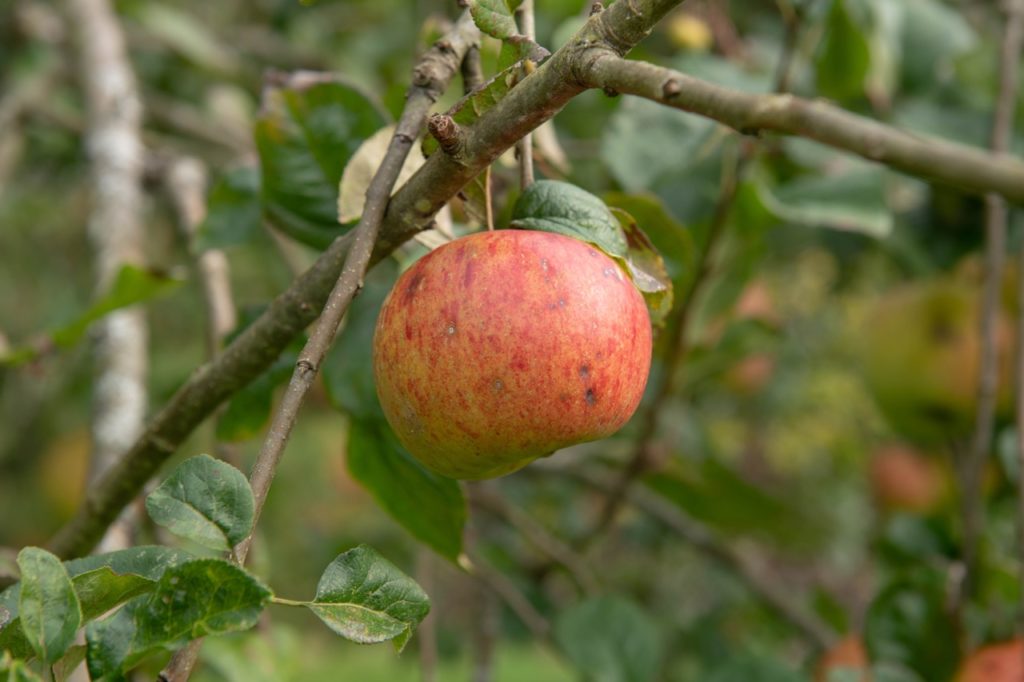
- COMMON NAME(S): apple ‘peasgood’s nonsuch’
- TYPE: DESSERT / CULINARY
- FLOWERS: pink
- FRUIT: yellow, red and green
- SUNLIGHT: full sun / part shade
- SIZE: 4-8m in height, 4-8m spread
One of the very special triple plays, ‘Peasgood’s Nonsuch’ is a dessert apple that is just as good as a culinary and cider apple.
The tree grows between 4-8m tall and is a reliable cropper.
It bears pinkish flowers and yellowish-green apples that are overlaid with red.
These huge, juicy apples have an especially sweet yet light flavour.
Harvest these delicious fruits in September for the best taste.
7) M. domestica ‘Blenheim Orange’
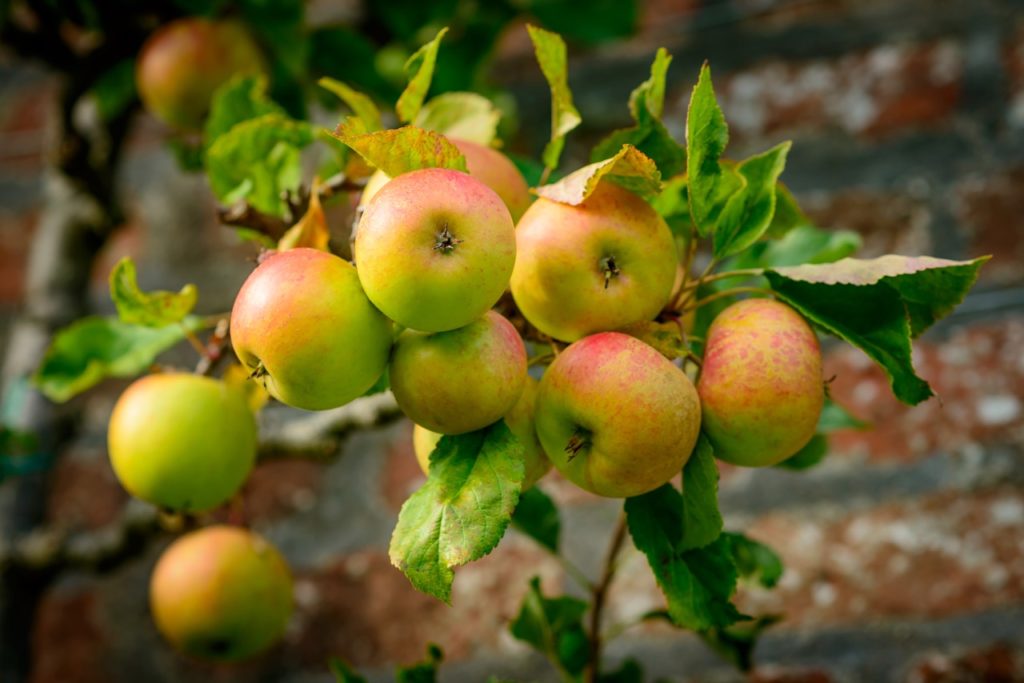
- COMMON NAME(S): apple ‘blenheim orange’
- TYPE: DESSERT / COOKING
- FLOWERS: pink
- FRUIT: yellow and red
- SUNLIGHT: full sun / part shade
- SIZE: 4-8m in height, 4-8m spread
‘Blenheim Orange’ is a triploid noted for its vigour.
This heirloom cultivar bears pink flowers and greenish apples that develop flushes of orange and red.
They are delicately sweet with a caramel-like nutty under-taste.
The harvesting season is usually from late September to early October.
Although it is a dessert apple, if its fruits are picked early it can also be used as a great cooking apple.
8) M. domestica ‘Pixie’
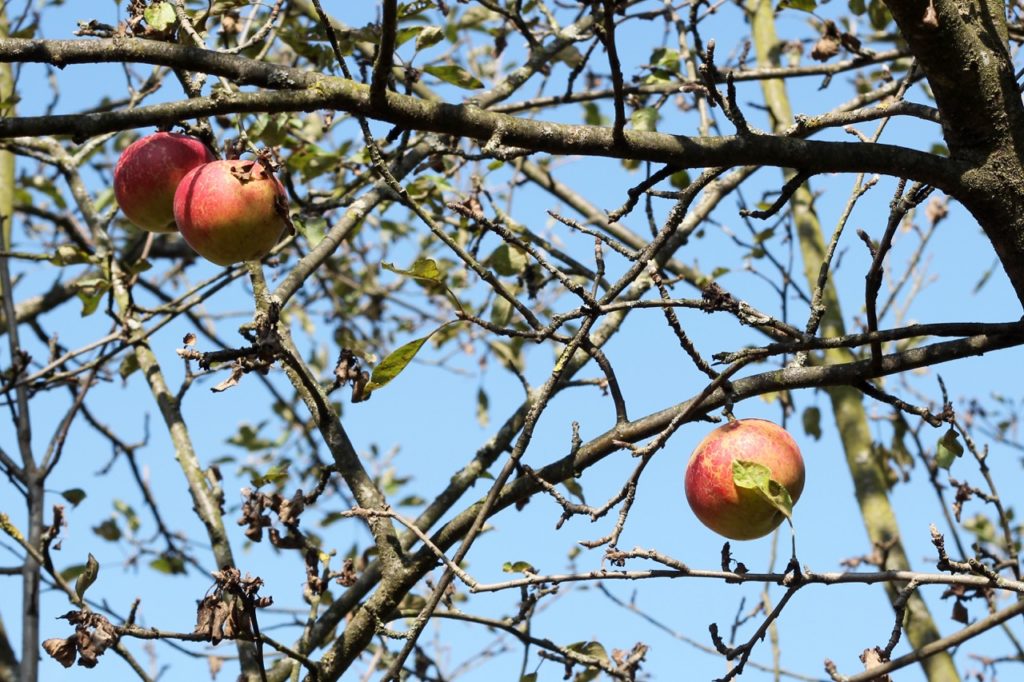
- COMMON NAME(S): apple ‘pixie’
- TYPE: DESSERT
- FLOWERS: pink
- FRUIT: green, yellow and red
- SUNLIGHT: full sun / part shade
- SIZE: 4-8m in height, 4-8m spread
Made in America, ‘Pixie’ is a little harder to find.
It reaches a height of 4-8m, but can be kept smaller, and is a heavy cropper.
It bears pink flowers and pale yellowish-green fruit with light red blushes.
The small apples are wonderfully scented and have a sweet, slightly tangy flavour and are juicy and crisp.
They are ready for picking from mid-September to mid-October.
9) M. domestica ‘Ribston Pippin’
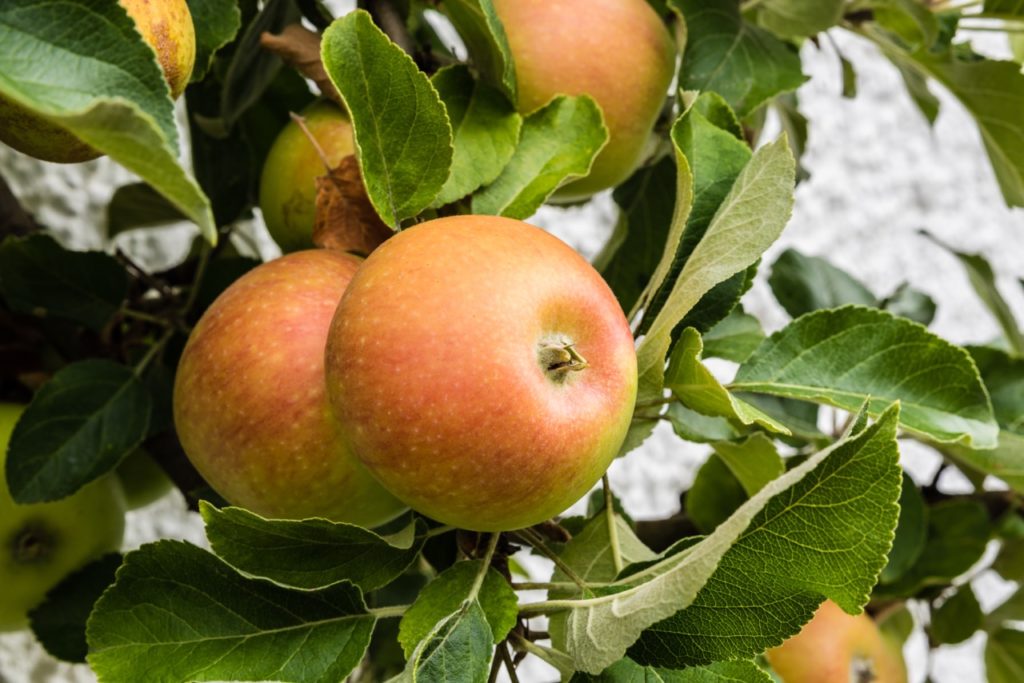
- COMMON NAME(S): apple ‘ribston pippin’
- TYPE: EATING / COOKING / DESSERT
- FLOWERS: pink
- FRUIT: red and yellow
- SUNLIGHT: full sun / part shade
- SIZE: 4-8m in height, 4-8m spread
‘Ribston Pippin’ is another one for the fruit-lover and is an heirloom variety that even precedes the famous ‘Cox’.
It bears bright pink flowers and has apples that are yellowy-green with orange flushes and shadings.
They are aromatic and have a rich and robust flavour, combining acidity and sweetness, and are best harvested in October.
10) M. domestica ‘Rosemary Russet’

- COMMON NAME(S): apple ‘rosemary russet’
- TYPE: CULINARY
- FLOWERS: pink
- FRUIT: orange, green and yellow
- SUNLIGHT: full sun / part shade
- SIZE: 4-8m in height, 4-8m spread
A vigorous tree that reaches a height of up to 8m, the heirloom ‘Rosemary Russet’ reliably produces good crops.
Beginning with light pink flowers, it brings forth greenish-yellow fruit with pale red tints.
Its fruits are well-known for their strong, sweet-sharp flavour.
A top choice for juicing, this dessert apple also lends itself to cooking – a true all-rounder.
11) M. domestica ‘Elstar’
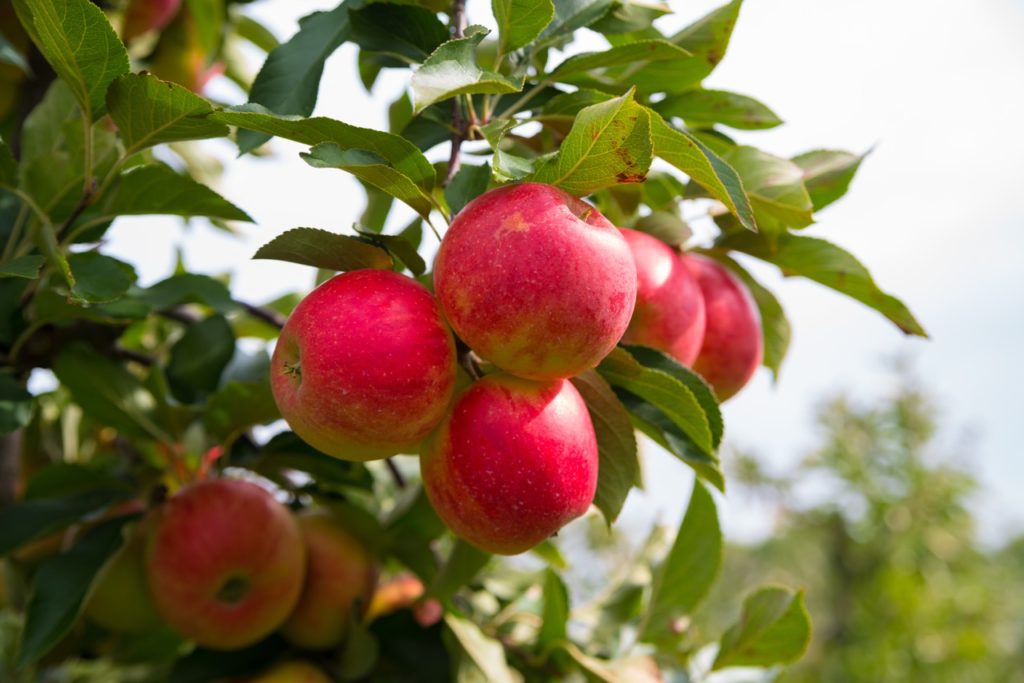
- COMMON NAME(S): apple ‘elstar’
- TYPE: EATING / COOKING
- FLOWERS: pink and white
- FRUIT: red and yellow
- SUNLIGHT: full sun
- SIZE: 2-4m in height, 2-4m spread
A European import from the 1950s, ‘Elstar’ is a heavy cropper.
The tree reaches 4-8m in height with half the spread and bears pink flowers.
The fruit is of a yellowy-green hue and is mostly overlaid with red marbling or patches.
It is a top-quality eating apple with a texture that is not overly crisp and a taste that is sweet and honeyed with a touch of acidity.
It is picked from mid-September to mid-October and is self-fertile.
12) M. domestica ‘Greensleeves’
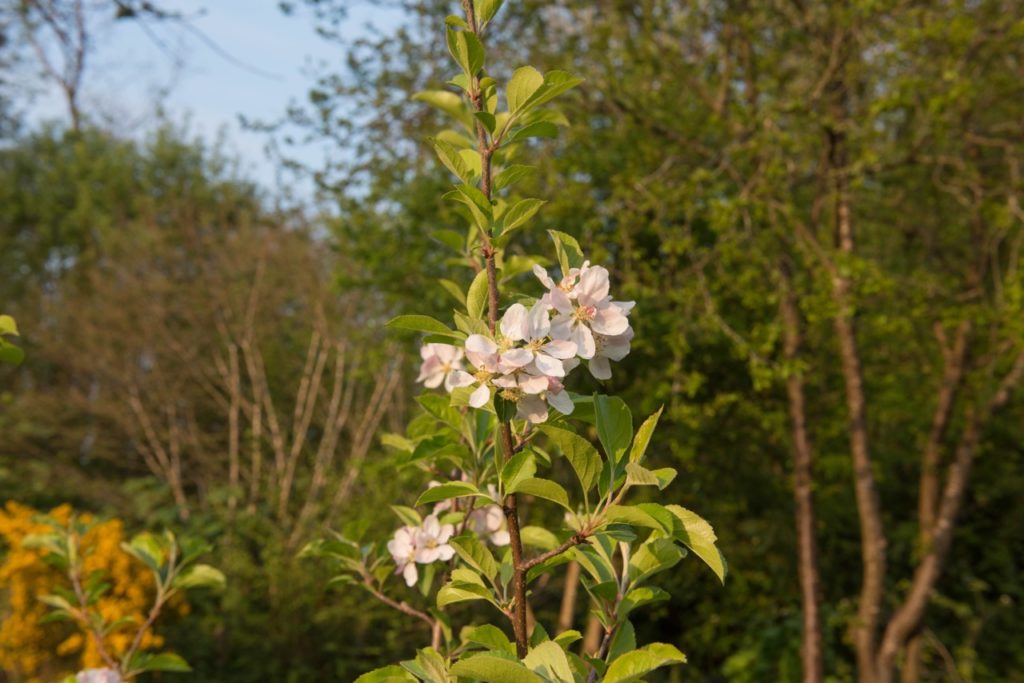
- COMMON NAME(S): apple ‘greensleeves’
- TYPE: DESSERT
- FLOWERS: pink
- FRUIT: green and yellow
- SUNLIGHT: full sun / part shade
- SIZE: 4-8m in height, 4-8m spread
Staying closer to the lower end of its 4-8m height, ‘Greensleeves’ is a top pick for small gardens or for container cultivation.
It is valued for cropping regularly and heavily and has light pink flowers that develop into light yellowy-green apples.
The crisp flavour of the fruit is finely balanced between sweetness and acidity and can be altered accordingly depending on when it is picked.
13) M. domestica ‘Worcester Pearmain’
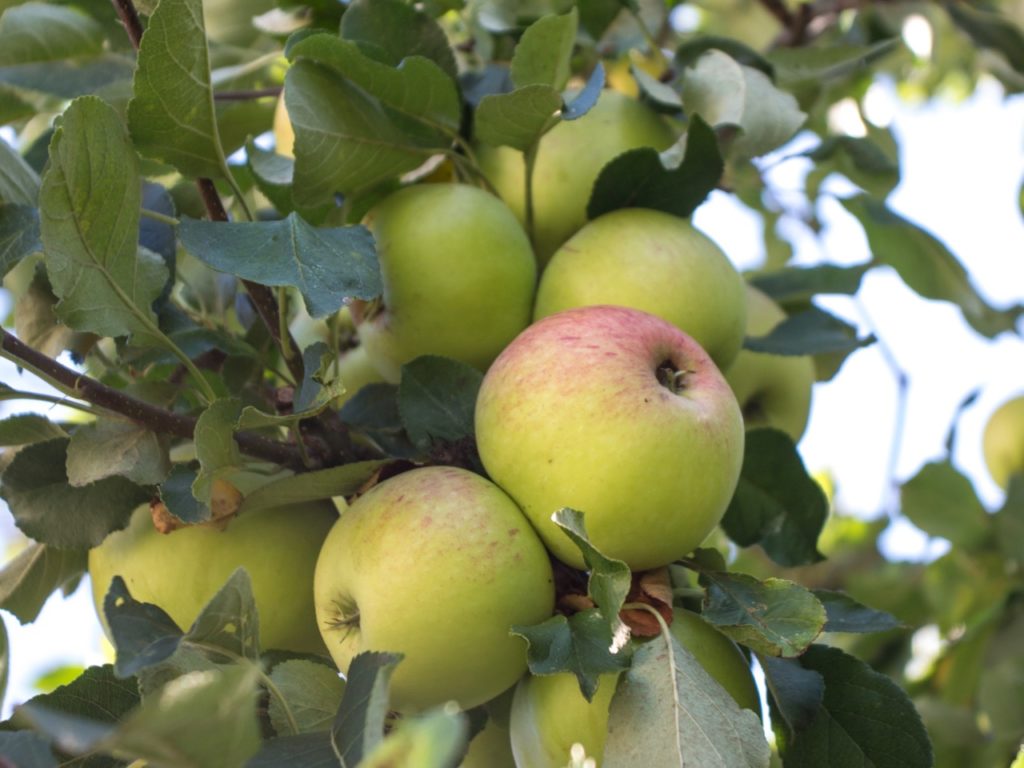
- COMMON NAME(S): apple ‘worcester pearmain’
- TYPE: EARLY DESSERT
- FLOWERS: pink
- FRUIT: red and yellow
- SUNLIGHT: full sun / part shade
- SIZE: 4-8m in height, 2.5-4m spread
‘Worcester Pearmain’ is another reliable and heavy cropper and is a trouble-free variety that is relatively easy to grow.
It bears particularly pretty pink flowers while the fruit has a yellowish base with rich red flushes.
This apple is renowned for its sweet, strawberry flavour and should be harvested through September.
This variety is self-fertile.
14) M. domestica ‘Red Windsor’

- COMMON NAME(S): apple ‘red windsor’
- TYPE: DESSERT
- FLOWERS: pink and white
- FRUIT: red
- SUNLIGHT: full sun
- SIZE: 1.5-2.5m in height, 1.5-2.5m spread
A diminutive 1.5-2.5m in height and spread, ‘Red Windsor’ can easily be grown in a postage-stamp-sized garden or in a container.
On top of that, it is also partially self-fertile and, for such a little tree, is an amazingly heavy cropper.
The pink flowers give way to rosy red fruit that are crisp and juicy with an aromatic sweetness.
The fruit is best harvested through early and mid-September.
15) M. domestica ‘Cox Orange’
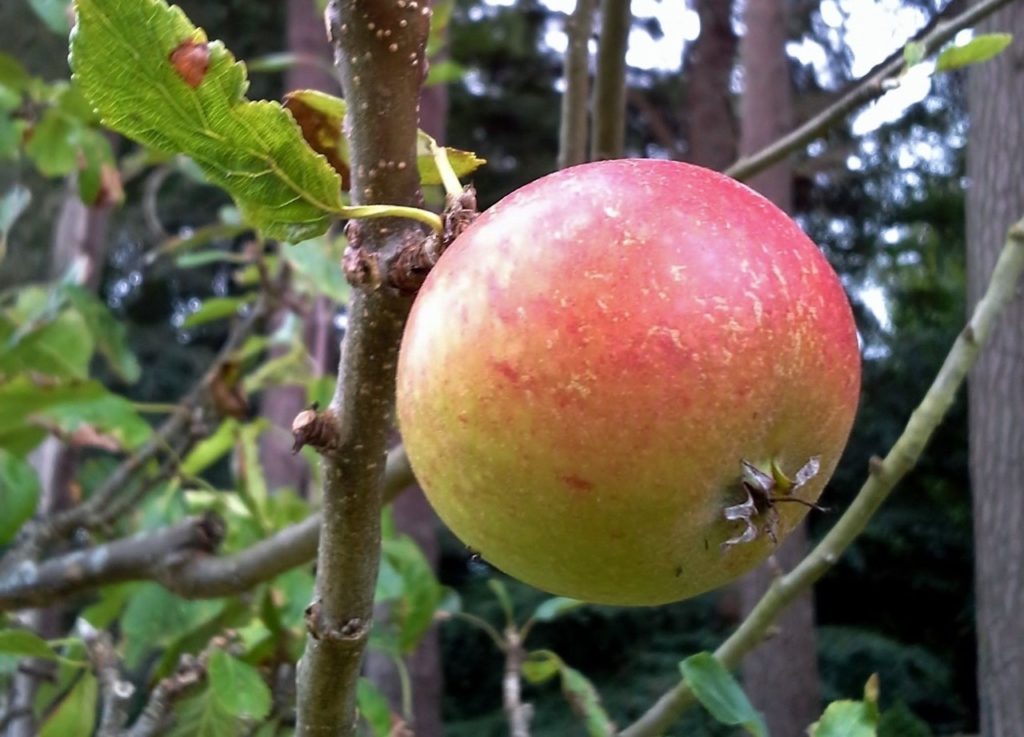
- COMMON NAME(S): apple ‘cox orange’
- TYPE: DESSERT
- FLOWERS: pink
- FRUIT: orange, yellow and red
- SUNLIGHT: full sun
- SIZE: 4-8m in height, 4-8m spread
This heirloom cultivar is difficult to grow and is the only variety on this list that has not received an RHS Award of Garden Merit.
Therefore, we do not recommend it for first-time growers or hobbyist gardeners.
However, the fruit from ‘Cox Orange’ is unparalleled.
The aromatic apple is celebrated for its complex and delicious flavour, bringing together undertones and hints of pear, mango and more.
This tree bears pink flowers and the apples are yellowy-green with rich orange or red shading and flushes.
The fruit is picked from mid-September to mid-October and is self-fertile.
References
- 1The Apple and the Rose. (2021, May 8). Apples and People. Retrieved March 9, 2023, from https://applesandpeople.org.uk/stories/the-apple-and-the-rose/
- 2E. (2020, September 20). History Of Bramley Apple Tree. Bramley Apples. Retrieved March 9, 2023, from https://www.bramleyapples.co.uk/bramley-apples-history/

